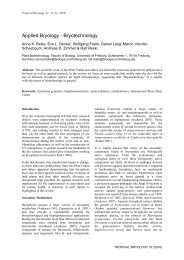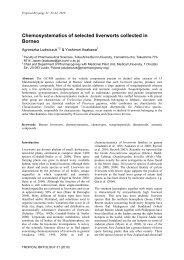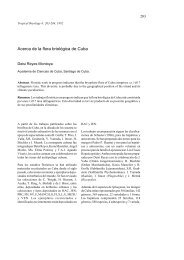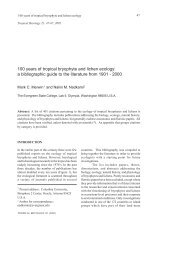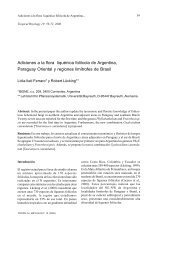Full text pdf - Tropical Bryology
Full text pdf - Tropical Bryology
Full text pdf - Tropical Bryology
You also want an ePaper? Increase the reach of your titles
YUMPU automatically turns print PDFs into web optimized ePapers that Google loves.
Revised checklist of Hawaiian mosses<br />
Status<br />
Following the taxonomy is a column<br />
indicating status of the taxon in the Hawaiian<br />
flora: end indicates an endemic, ind indicates<br />
indigenous, and nat signifies naturalized. A ?<br />
following any of these signifies uncertainty about<br />
the status of the taxon in the Hawaiian flora. While<br />
some research has been devoted to the mode of<br />
introduction of pteridophytes and angiosperms<br />
to Hawai‘i, resulting in a list of species that are<br />
likely to have been introduced by Polynesian<br />
voyagers that settled the archipelago and another<br />
(much larger) list of plants that arrived following<br />
European contact, little attention has been<br />
devoted to bryophytes in this regard. The authors<br />
have used their best judgment in cases where<br />
the status is not clear and appended a ? to<br />
whatever status we assigned, to draw attention<br />
to the species and invite investigation from<br />
specialists.<br />
One case worth noting is Racopilum<br />
cuspidigerum, which is widespread in the<br />
Southern Hemisphere but is found only in the<br />
Hawaiian Islands in the Northern Hemisphere. It<br />
is a prime candidate as a Polynesian introduction<br />
to Hawai‘i, and indeed to many of the other<br />
Polynesian islands in the South Pacific (S. Olson,<br />
pers. comm.).<br />
Island distribution<br />
Following the status category is a<br />
summary of geographic distribution on the eight<br />
main Hawaiian Islands. The island name<br />
abbreviations are explained at the foot of each<br />
page. An island abbreviation appears in the row<br />
to the right of the taxon name to signify that the<br />
taxon is reported in the literature from that island.<br />
Absence of the island name abbreviation<br />
indicates the moss is not (yet) known from that<br />
island. Given the inadequate state of moss<br />
collecting in the Hawaiian Islands, many new<br />
island distribution records are sure to be found<br />
in the future.<br />
Synonym list and Literature Consulted<br />
Following the main body of the checklist,<br />
an alphabetical list of all synonyms and<br />
misapplied names is provided. This list crossreferences<br />
every synonym or misapplied name<br />
to the main entry found under the scientific name<br />
TROPICAL BRYOLOGY 25 (2004)<br />
37<br />
accepted in this checklist. The checklist<br />
concludes with a bibliography of the references<br />
cited in the checklist; more than 130 bryological<br />
titles were consulted in the course of the project,<br />
but only those providing taxonomic or<br />
distribution data pertinent to this checklist are<br />
included here.<br />
Anomalies and incomplete records<br />
A few moss names without any island<br />
distribution are included, based on (mostly) older<br />
literature that reports the species from the<br />
Hawaiian (or sometimes Sandwich) Islands<br />
without stating on which island the species was<br />
found. Two examples in the list are Dicranoweisia<br />
cirrata and Plagiothecium denticulatum. Their<br />
presence in the Hawaiian Islands needs to be<br />
confirmed and documented with contemporary<br />
collections.<br />
Another anomaly is Mniobryoides<br />
degeneri, an invalid name published without a<br />
description or indication of a type specimen by<br />
H. Hörmann. It has been pointed out (S. Olson,<br />
pers. comm.) that this is probably a<br />
misidentification for some well-known species.<br />
However, M. degeneriae has never been assessed<br />
by a competent bryologist to ascertain its true<br />
identity. We leave the name in the checklist to<br />
point out that more study is required.<br />
A note about family circumscriptions<br />
The past 25 years has brought an<br />
explosion in research on bryophyte systematics<br />
and a great deal of new information has accrued,<br />
which has led to many changes in moss<br />
classification. Family classification in particular<br />
has become increasingly problematic as new data<br />
provide insights into relationships between<br />
genera. Several new families have been erected<br />
and other genera have been reassigned. We have<br />
indicated the family where Hoe (1974) assigned<br />
each genus, followed by alternative family<br />
assignments where these were discovered. Two<br />
principle reference works were consulted for<br />
family assignments: first, Bryophyte Biology<br />
(Shaw & Goffinet 2000), and in a few cases the<br />
bryological nomenclator included in the<br />
W 3 MOST database of mosses (http://<br />
mobot.mobot.org/W3T/Search/most.html) on the<br />
TROPICOS website.




